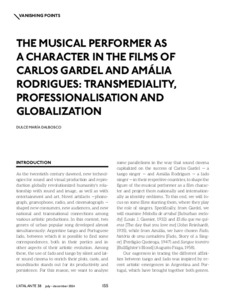Por favor, use este identificador para citar o enlazar este ítem:
https://repositorio.uca.edu.ar/handle/123456789/19099| Título: | The musical performer as a character in the films of Carlos Gardel and Amalia Rodrigues: transmediality, professionalization and globalization El intérprete musical como personaje en las películas de Carlos Gardel y Amalia Rodrigues: transmedialidad, profesionalización y globalización |
Autor: | Dalbosco, Dulce María | Palabras clave: | TANGO; FADO; CANTANTES; PERSONAJES; CINE ARGENTINO; CINE PORTUGUES; Gardel, Carlos, 1890-1935; Rodrigues, Amália, 1920-1999 | Fecha de publicación: | 2024 | Editorial: | Asociación Cineforum L'Atalante | Resumen: | The emergence of sound cinema around the thirties drew plot inspiration from various urban and popular musical genres that were
flourishing at the time. Cinema quickly seized the opportunity to
capture sound and image simultaneously and integrated singers who
were already idolized during the early decades of the twentieth century into its star system. In this context, the musical performer not
only became a cult figure but also became transmedial, regularly appearing as a cinematic character. On this occasion, we aim to analyse
some parallelisms in how sound cinema capitalized on the success of
Carlos Gardel — tango singer — and Amália Rodrigues — fado singer
— in their respective countries, to shape the figure of the singer as
a film character and project them nationally and internationally as
identity emblems. To this end, we will analyse some films starring
them, where they play the role of singers. From Gardel, we will take
Melodía de arrabal [Suburban melody] (Louis J. Gasnier, 1932) and El
día que me quieras [The day that you love me] (John Reinhardt, 1935),
while from Amália, we have chosen Fado, história de uma cantadeira
[Fado, Story of a Singer] (Perdigão Queiroga, 1947) and Sangue toureiro [Bullfighter’s Blood] (Augusto Fraga, 1958). El surgimiento del cine sonoro en torno a la década de los treinta del siglo XX encontró inspiración argumental en distintos géneros musicales urbanos y populares, que se hallaban en auge por ese entonces. De este modo, el cine pronto aprovechó la posibilidad de recoger sonido e imagen de manera simultánea e integró a su star system a los cantantes ya idolatrados durante las primeras décadas del siglo XX. En este marco, el intérprete musical no solo se transformó en una figura de culto, sino que él mismo se vuelve transmedial y se convierte en un personaje cinematográfico habitual. En esta ocasión queremos analizar algunos paralelismos en la forma en que el cine sonoro sacó ventaja del éxito de Carlos Gardel —cantor de tangos— y de Amália Rodrigues —fadista— en sus respectivos países, para modelar la figura del o de la cantante como personaje cinematográfico y proyectarlos nacional e internacionalmente como emblemas identitarios. Con este fin, analizaremos algunas películas protagonizadas por ellos, donde representan el papel de cantantes. De Gardel tomaremos Melodía de arrabal (Louis J. Gasnier, 1932) y El día que me quieras (John Reinhardt, 1935), mientras que de Amália hemos escogido Fado, história de uma cantadeira (Perdigão Queiroga, 1947) y Sangue toureiro (Augusto Fraga, 1958). |
URI: | https://repositorio.uca.edu.ar/handle/123456789/19099 | ISSN: | 1885-3730 (impreso) 2340-6992 (online) |
Disciplina: | LITERATURA | Derechos: | Atribución 4.0 Internacional | Fuente: | L'Atalante revista de estudios cinematográficos. 2024 (38) |
| Aparece en las colecciones: | Artículos |
Ficheros en este ítem:
| Fichero | Descripción | Tamaño | Formato | |
|---|---|---|---|---|
| musical-performer-character.pdf | 746,5 kB | Adobe PDF |  Visualizar/Abrir |
Este ítem está sujeto a una Licencia Creative Commons

